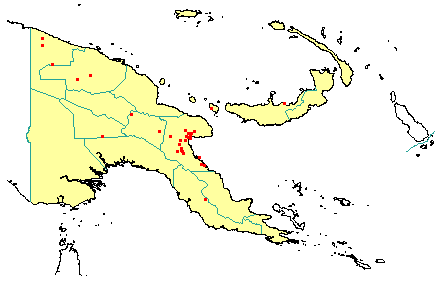
in PNGplants database
PNGTreesKey – Aphanamixis polystachya (Wall.) R.N.Parker |
Barry Conn (NSW) & Kipiro Damas (LAE).
Guide to trees of Papua New Guinea
Copyright held by the authors, National Herbarium of New South Wales, and Papua New Guinea National Herbarium
Indian Forester Vol. 62: 486 (1931)
Other Literature: D.J. Mabberley & A.M. Sing, Flora Malesiana, Series 1 188-193 (1995)
Family: Meliaceae
Dicotyledon
Timber Group: Occasional timber species
Field Characters: Large canopy tree (up to 25 m high, rarely to 35 m); Bole cylindrical or markedly fluted (slightly up to 100 cm diam.); often crooked or straight (bole up to c. 15 m long); buttresses buttresses present (buttresses 1-4 m high); spines spines absent; aerial roots aerial roots absent; stilt roots stilt roots absent; Bark brownish red or pale brown, rough, scaly or flaky; Subrhytidome (under-bark) red (bright red); less than 25 mm thick (5-6 mm thick), 5.0-8.0; bark blaze consisting of one layer; strongly aromatic; pleasant; outer blaze red, markings absent, fibrous; inner blaze red, markings absent, fibrous; bark exudate (sap) present, white/milky, not readily flowing (spotty), colour not changing on exposure to air, sticky; terminal buds not enclosed by leaves.
Indumentum: Complex hairs absent; stinging hairs absent; mature twig indumentum (hairs) absent.
Leaves: Leaves spaced along branches, spiral (leaves occurring singly at a node and arranged spirally up the branchlet), compound (a leaf made up from two or more leaflets); petiole present, not winged, attached to base of leaf blade, swollen (at base and inhabited by ants); leaves pinnate (unbranched with more than three leaflets); petiolule not swollen; rachis present, absent, absent; leaves with a terminal leaflet (the number of leaflets odd - imparipinnate), broadest below middle, (7.5-) 9.5-25.0 cm, (4.0-) 5.5-8.0 (-9.0) cm, leaflets opposite, asymmetric, terminal developing leaflet buds straight; venation pinnate, secondary veins open, prominent, intramarginal veins absent; leaves lower surface green, upper surface green, indumentum (hairs) absent; absent; domatia absent; stipules absent.
Flowers: Inflorescence axillary (sweetly aromatic), flowers on an unbranched axis, cones absent; flowers unisexual or bisexual, unisexual with male and female flowers on different plants, stalked (shortly), flowers with many planes of symmetry, 3.0-5.0 (-7.0) mm long, diameter small (up to10 mm diam.) (4-9 mm diam.); perianth present, with distinct sepals and petals whorls, inner perianth pale yellow or cream-coloured (sometimes tinged with red); 3, some or partly joined; stamens 3-8, present, joined (to form a staminal tube), at base joined to the perianth; ovary superior, carpels joined (when more than one), locules 3 (-4); styles solitary, 1.
Fruits: Infrutescence arranged on unbranched axis, fruit 20.0-40.0 mm long, yellow when young or pale red, not spiny, slightly fleshy, simple, dehiscent, capsule; seeds 1-3, much more than 10 mm long (17-20 mm long), not winged, narrow (longer than wide), seed 1-10 mm diam. (c. 6 mm diam.).
Distribution: West Sepik, East Sepik, Madang, Morobe, Western Highlands, Eastern Highlands, Southern Highlands, Western, Gulf, Central, Northern, Milne Bay, New Britain, New Ireland & Manus.
 | Botanical records in PNGplants database |
Notes: Notes Includes: Aphanamixis macrocalyx Harms; Aphanamixis myrmecophila (Warb.) Harms.